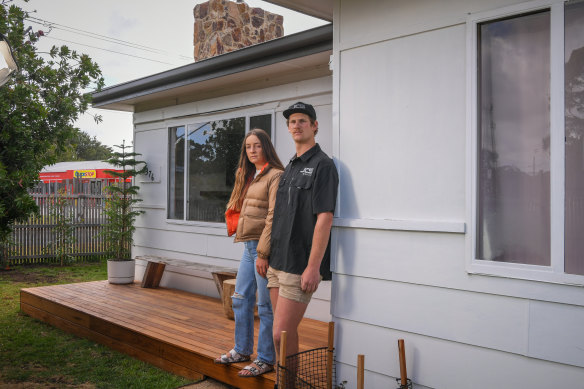First home owners knew rates would rise. But not this fast
Key points
- Melbourne home owners are tightening their belts to meet their rising mortgage repayments.
- Economists expect a challenging year for Australia’s mortgage belt.
- Brokers encourage anyone stretched to ask their broker or bank for assistance.
Property listings
First home owners Jarrad Smith and Madeleine Davidson were already tightening their belts, spending less and trying to save more money before interest rates rose for the 10th straight time on Tuesday.
Like many Australians, they say the increase will make their life tougher, forcing them to work extra hours to meet their rising mortgage repayments.
Madeleine Davidson and Jarrad Smith bought their Crib Point home before interest rates started to rise.Credit:Justin McManus
On Tuesday, the Reserve Bank board added another 0.25 of a percentage point to the cash rate, taking it to 3.6 per cent.
The couple, both aged in their mid-20s, bought a three-bedroom fixer-upper in Crib Point, on Melbourne’s Mornington Peninsula, at the end of 2021. They moved in at the start of 2022, while interest rates were still at record lows.
“We were already informed that rates were super low and could go up, but we weren’t expecting 10 rises in a year,” Smith said. “So now we’re working a few more hours in the day and making the extra dollars we need.”
The couple has been saving hard to renovate their home, but fear this will take longer than planned.
“We’re definitely not eating out as much as we had been or going out for drinks with friends, or paying for drinks,” Davidson said. “We’re not going to music festivals. All the social things we’ve cut out, really.”
Smith said travelling overseas was off the cards for the couple, as higher mortgage repayments and rising expenses, including groceries, also hit their hip pockets. The couple already stopped doing full weekly grocery shops to avoid wasting food getting old in their fridge, and now prefer to shop for a few days at a time.
The rise in interest rates will cause more pain for homeowners across the country, including the Crib Point couple.
The latest hike tips the monthly increase over four figures for those with a $500,000 loan. Such a borrower is now paying $1051 more per month than they were forking out before the rate hike cycle, Canstar modelling shows. Repayments of $2103 per month in April last year are now up to $3154 a month.
Those with a $750,000 mortgage will now pay an extra $1577 each month, while homeowners with a $1 million loan have watched their repayments rise by $2103.
Westpac senior economist Matthew Hassan expects more pain to come for those with mortgages, with another two interest rate rises likely in April and May.
“It’s going to be a very challenging year for the mortgage belt in Australia,” Hassan said. “They will be facing a very severe stress test.”
But Hassan said rises were necessary to tackle the problem of inflation.
“There is an inflation emergency in Australia – inflation is not just high but far too high, and it needs to be dealt with before the RBA (Reserve Bank of Australia) can focus on growth again.”
Although house prices in Sydney and Melbourne steadied in January and February, when clearance rates were above 60 per cent, Hassan said it was too premature to say house prices would improve.
He expects a peak-to-trough fall in prices of 16 per cent nationally. Other economists, including AMP Capital’s Dr Shane Oliver, expect the ball to be between 15 per cent and 20 per cent.
Though homeowners would be under a growing amount of stress, Hassan is not expecting a rush of distressed home sales.
An inflation emergency means interest rates have to rise, Matthew Hassan says.Credit:Rhett Wyman
“Homeowners are still in good shape because many have a good buffer of accumulated savings [from COVID],” Hassan said. “Lenders have quite a few tools to allow homeowners to manage stress as it arises.”
Foster Ramsay Finance director Chris Foster Ramsay, who helped Smith and Davidson get their loan, said the banks were already speaking with brokers about what they could offer to help ease the burden for people close to the edge.
“They’re talking about returning to COVID rules where special arrangements are put in place to try and assist the best way they can,” Foster Ramsay said.
Foster Ramsay said some homeowners he helped get into the market before rates began to rise were starting to discuss how the increased rates were impacting them.
“They’ve been saying to us, ‘it’s becoming close to being problematic in the family budget,’ and they’ve been asking advice about what they should do,” he said. “Other clients that we know, we’ve been able to pick up that they are stretched but aren’t talking about it; they’re pretty much keeping it quiet.
“But I think the message needs to change from these 10 rises to: people need to reach out and speak to their brokers or banks to get help in a similar way to what was happening during COVID.”
Most Viewed in Property
Source: Read Full Article

